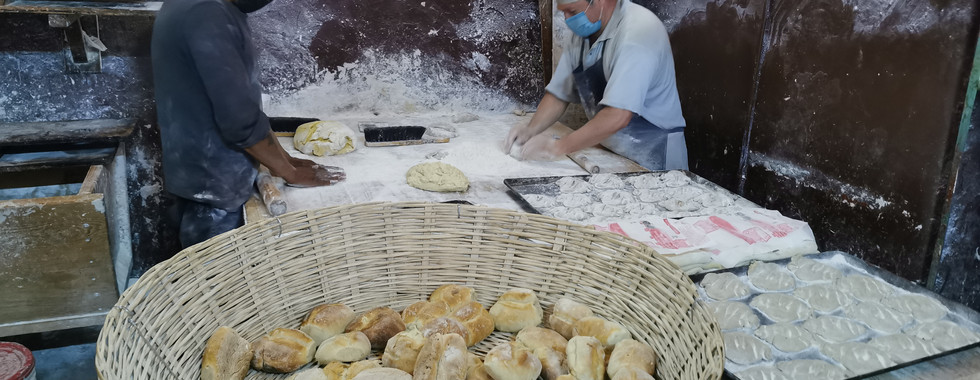Home of mole | Puebla
- Timo Lederer
- 13. März 2022
- 5 Min. Lesezeit
Culinary experiences are important in México. As one of the least countries, the Mexican cuisine is an Intangible Cultural Heritage of Humanity stated by UNESCO. Fun fact, France applied multiple times and got rejected, which might give you a feeling of how special this distinction is.
Chilaquiles, Tacos, Enchiladas, Empenadas, Chiles rellenos, Chiles Ahogadas, Tostadas, Tortas, Gringas, Quesadila, Tamales, Pozole... the list is long, but one is special - Mole. In general, the term describes a huge variety of sauces that are cooked for a long time (some even for years), consists of dozens of ingredients, and can taste totally different, but all have in common to be based on chilis. Also, the term is well known for some sauces, which are also based on chocolate which is what one might expect to try. The origin of Mole or at least Mole de Poblano is stated to be in Puebla, our next stop.

So without question, our first stop was in a restaurant to try Mole in Puebla for lunch after arriving. The dish that we got in La Mexicana (which has a quite cute inner yard) was tasty but so different from the Mole I had in Guadalajara. This was surprising for us in the first place, but after we learned more about Mole as described above, not anymore.

During our afternoon stroll, we came along the Zócalo (the central square), where traditional dances took place, probably because of the national holiday. On my way, I got finally a Mazapán which is all around Mexico in shops as a small snack or sold by some elderly on the street. It is raw marzipan mostly from the brand 'de la Rosa' packaged in small portions which you can buy for some pesos and it is 100% worth a try since it is so tasty. At one point later (hopefully not because of the candy), we both did not feel well anymore, so we went back to the hostel and only got some pizza from Doctor Pizza, which was very big and quite recommendable if you want a Mexican food break.
Our hostel of that night 'Posada Vee Yuu' had a very chilled vibe and a small rooftop and was also offering free breakfast, which we enjoyed, but we still moved to Casa Pepe for the next two nights, because we had no Wifi in the room, only a cold shower (quite typical in Mexico) and the people working there were not helpful at all, plus we enjoyed the stay in Casa Pepe in CDMX so much. After breakfast, I went on a free walking tour with only 4 other people, which brought us to the main church, the Mercado de Artesanías El Parián, the art district, Frog street (which is very well known and cute), a place where we were shown how Talavera is produced, the small bakery El Hornito de San Francisco where we were able to see how Mexican bakeries work, the Ex-Convento de San Francisco, where we saw people getting their new cars baptized or blessed and a candy shop (Santa Clara pancakes) where we got two typical and tasty sweets of Puebla: Camote and Tortitas de Santa Clara. While being in Frog street the guide explained the name, which is a result of frogs living in this area before a river was relocated because floods were causing diseases.

For lunch, we went to Cocina Sabores de Puebla in the hope to try Chiles Ahogadas, but unfortunately, they told us as many others that it is not their season. Still, it was a nice place which first offered a small plate with different salsas and moles to try to, first of all, get the idea of all the options and be able to decide later which one you would like.
After power hour in the hostel, we went for diner to La Berenjena which is well known for its special Pizza, and finally to a recommended place of our receptionist: Mezcalería Miel de Agave.
After first popping in there and seeing only shots on the menu, we thought we will only stay for one drink since this is how locals drink it. This idea lasted exactly until Andres, the owner showed up and stayed with us for more than one hour explaining to us everything about Mezcal, Tequila, how different production processes work, who is responsible for which bottle of liqueur in his store as well as how to drink it and what we need to check before buying one. Also, he explained and showed us on private videos how Mole is typically made and how lava stone is used for this purpose as a grinder. This is how this evening ended up to be one of the best of our vacation - so ask for him if you're there.

Some Infos in a nutshell:
210 different Algarve types (25% from Oaxaca)
Artesano or Ancestral techniques to produce in the traditional way
Tepeztate is a special type that only grows on steep rocky cliffs and takes at least 25 years to grow (10kg Algarve for one bottle; around 400$/18€ per shot)
Fun fact: Caesar salad is 'Mexican'


The next day I had a morning run in the Parque Ecológico which offers a nice path around the lake as well as possibilities for different sports and a glass dome with different bird species.
After breakfast in the hostel, Pauline took over the planning again, which I really appreciated and we went to Biblioteca Palafoxiana, the first public library in Latino America which offers an impressive room filled with decor and old books. The next stop was Museo Regional De La Revolución which represents as the house of the Serdán Alatriste family one of the starting points of the Mexican Revolution in 1910 when police ordered by Porfirio Díaz started shooting at it because they identified the family as critical against the long term president and as supporters of an arising rebellion. The exhibition which is partly in English shows the living conditions at that time and the flow of happenings.
The next history lesson took place in the Ex Convento de Santa Rosa also known as the birthplace of mole poblano. This building hosts a typical kitchen of the 17/18th century decorated with Talavera tiles which leads to a very special atmosphere. Also, it holds an exhibition about masks and typical dressings, art, pottery beyond others. Important to mention, all those museums or convents have very little admission fees in Mexico at around 40-70$/2-3€.
As the last stop of the day, the others went to Capilla del Rosario which is well known for its plenty of golden decor while I went to Mercado de 5 mayo to search for a Molcajete which is a typical Mexican mortar and pestle or blender out of basalt/lava stone. It is used for blending spices and making guacamole or salsas as mole, too. Also, like a cast-iron skillet, the Molcajete is 'seasoning' every dish with flavors of last prepared dishes because it is not possible to fully clean the tool, because of its texture with many small holes due to the basalt structure which also supports the grinding process. Since it is made from Lavastone and Puebla is located directly at Malinche volcano which can be climbed, I wanted to get the Molcajete here even though I knew I'll have to carry it around until the end of my trip and it has more than one kilogram of weight. After asking around a bit in the trouble of the market, which was really lively and one of the most active ones I saw in Mexico, I found a small stand where I was able to buy a mid-sized one for 180$/8€ which made me really happy and I'm looking forward to using it at home. On my way back to the hostel and the bus I grabbed a Cemita poblana (35$) which is a typical sandwich in Puebla and perfect food for a 6h trip.






















































Kommentare